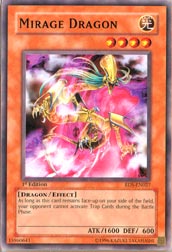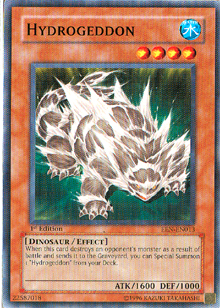Cards such as Dekoichi the Battlechanted Locomotive and Skelengel are popular because they effectively replace themselves when their flip effects trigger, and can provide some fast stability to a deck that needs to dig into new options quickly. However, these cards are definitely not aggressive. In fact, most of the decks dominating the Shonen Jump Championships these days run very slow cards, with most of the top players focusing on launching late-game bombs such as Chaos Sorcerer and Return from the Different Dimension on their opponent.
 What does this mean for players who favor an aggro, or aggressive, style of play? Are aggro cards so bad that nobody is willing to touch them, or are they simply overlooked for the slower cards that possess the Light and Dark attributes? Of course not! In fact, some amazing aggro cards have seen increased play (sometimes in the wrong decks) over the past month. Mirage Dragon is a great example of a card that caters to an aggressive style of play.
What does this mean for players who favor an aggro, or aggressive, style of play? Are aggro cards so bad that nobody is willing to touch them, or are they simply overlooked for the slower cards that possess the Light and Dark attributes? Of course not! In fact, some amazing aggro cards have seen increased play (sometimes in the wrong decks) over the past month. Mirage Dragon is a great example of a card that caters to an aggressive style of play.
However, what makes agro . . . well, “aggro”? How does this style of play differ from the slower control style, and what are the benefits of going down this route? How does a card such as Hydrogeddon—the card that I will be examining today—work as the perfect example of a solid aggro card?
What is Aggro?
Aggro can best be explained through the very first decks to be released in the Yu-Gi-Oh! Trading Card Game. When Metal Raiders was the newest set, the most popular deck type was Fiend/Spellcaster beatdown. It was a primitive example of an aggro deck, but the concept was still very aggressive. The deck ran various forms of monster removal accompanied by the strongest level four monsters available at the time. It didn’t bother focusing on slow flip effect monsters, such as Magician of Faith because the beatdown player was too busy smashing face with vanilla monsters. At the time, the strategy involved with this aggro deck was limited. If you were to go back to the time when Metal Raiders was the latest set, an aggro player could also include copies of cards such as Reinforcements in order to dominate the mirror match through uninterruptible damage step trickery.
Duelists can generally adapt the agro style of play with a deck that involves the best early game available in the Yu-Gi-Oh! TCG. Your goal is to place pressure on your opponent immediately. Unlike in a control matchup, where the two control duelists focus primarily on keeping their respective options up and their opponent’s options down, an aggro player can actually sacrifice the concept of card advantage and over-commit monsters to the field in order to put the opponent under intense pressure. The goal of an aggro player is to win as quickly as possible, which is incredibly important against control decks. While over-committing monsters to your field can be very dangerous, it also forces your opponent into a difficult position. If he or she has another two turns left before losing all his or her life points, he or she must deal with your monsters before setting up stability through flip effect monsters, which will further delay his or her ability to play stabilizing monsters and win conditions (in most Shonen Jump Championship matches, those stabilizing card win conditions are Chaos Sorcerer, Zaborg the Thunder Monarch, and Return from the Different Dimension). If you force your opponent’s life points down as far as they can go, he or she must draw a method of destroying your board (such as a Mirror Force) or risk losing the duel. The ability to play fast and deadly while limiting your opponent to a tiny handful of victory options is what aggro does best.
Of course, while the strategy can be very powerful, there are some considerable risks involved with attempting to smash face. As an aggro player, you must always have a better field and higher life points than your opponent. If the opponent sits safe at 8000 life points, then he or she won’t feel too pressured if you have one extra monster on your field. Likewise, if he or she can deal with your aggressive field of monsters, such as using a Mirror Force or Snatch Steal, then he or she can quickly turn an amazing scenario for you into a very grim uphill battle. This makes aggro decks a dangerous choice for the format. However, some alternate aggressive methods are available to players who wish to put some fast-paced pressure on their opponents.
One of the most useful strategies available to an aggro player is the ability to play monsters with strong lasting power. For example, an aggressive Zombie deck would love to get Vampire Lord onto the field as soon as possible. Not only is it capable of taking out just about every monster with a level lower than five, but its effect protects your field from being wrecked by removal cards such as Mirror Force and Sakuretsu Armor. While monsters such as Cyber Dragon could be a potential problem, stat-manipulating support cards such as Rush Recklessly can easily deal with them. Eventually with this strategy, you should force your opponent to waste his or her removal on Vampire Lord just to stay alive. The advantage to this strategy is that it’s very consistent with the Zombie support available, and you can actually gain an advantage by making many of the cards in your opponent’s hand or deck completely useless while staring down Vampire Lord.
The other strategy available to aggro involves getting monsters onto the field quickly without losing cards of your own. This means using methods to summon more monsters from your deck or graveyard instead of your hand—one of the reasons why the Gravekeepers make for a solid aggro deck (Gravekeeper’s Spy is absolutely nuts in this regard). This also excludes how insanely easy it is for the Gravekeeper deck to always have a monster on the field . . . which also leads into my reason for highlighting . . .
Hydrogeddon, Aggro’s Best Friend
 Summoning extra monsters per turn is astounding for an aggro player. Summoning extra monsters without having to over-commit your actual cards is even better. Hydrogeddon is easily one of the best aggro monsters to ever be released in the Yu-Gi-Oh! TCG. Its 1600 ATK is respectable in this format, and it possesses the ability to trample over every single threatening flip effect monster in this game (sans something like Gravekeeper’s Spy). The best part is that Hydrogeddon actually gives you another solid attacker whenever it destroys and sends a monster to the graveyard as a result of battle. If this is the first turn and you manage to trample over a Dekoichi the Battlechanted Locomotive, you can get another Hydrogeddon that can crash into the opponent directly. Not only did your opponent lose field presence, but he or she also took a hit in life points. Now he or she is hard-pressed to be aggressive, which no control player wants to do early in the game. If you force him or her into a defensive position, you can wreck the field next turn with your attacks while possibly summoning a third Hydrogeddon to your field for free. Then your next battle phase looks to cause at least 3200 points of life point damage to your opponent, forcing him or her to destroy your field during next turn. If he or she can’t hold off your offensive, you win the duel!
Summoning extra monsters per turn is astounding for an aggro player. Summoning extra monsters without having to over-commit your actual cards is even better. Hydrogeddon is easily one of the best aggro monsters to ever be released in the Yu-Gi-Oh! TCG. Its 1600 ATK is respectable in this format, and it possesses the ability to trample over every single threatening flip effect monster in this game (sans something like Gravekeeper’s Spy). The best part is that Hydrogeddon actually gives you another solid attacker whenever it destroys and sends a monster to the graveyard as a result of battle. If this is the first turn and you manage to trample over a Dekoichi the Battlechanted Locomotive, you can get another Hydrogeddon that can crash into the opponent directly. Not only did your opponent lose field presence, but he or she also took a hit in life points. Now he or she is hard-pressed to be aggressive, which no control player wants to do early in the game. If you force him or her into a defensive position, you can wreck the field next turn with your attacks while possibly summoning a third Hydrogeddon to your field for free. Then your next battle phase looks to cause at least 3200 points of life point damage to your opponent, forcing him or her to destroy your field during next turn. If he or she can’t hold off your offensive, you win the duel!
The best part about this strategy is that you aren’t actually risking any of your cards through Hydrogeddon’s effect. In fact, it consistently provides you with advantages every turn. Three Hydrogeddons also make a great combo with Pot of Avarice, which not only will provide you with pure card advantage, but also shuffles back a used set of Hydrogeddons into your deck for future rampaging later in the duel. This is a great method for aggro players to deal with the self-replacing flip effect monsters that everybody runs these days, and it should definitely be one of the first considerations for anyone who wishes to win faster than a control player can stabilize.
The elements and strategy behind the aggro play style single-handedly explains why Hydrogeddon is one of the game’s best monsters. It’s best to think of Hydrogeddon as the aggro alternative to Thunder Dragon. While Thunder Dragon provides you with a solid deck-thinning outlet and fuel for powerful and controlling discard effects, Hydrogeddon provides a deck-thinning outlet that contributes to a dangerous field of monsters to threaten your opponent. The Hydrogeddon’s Water attribute may also prove useful with cards such as Spiritual Water Art - Aoi, which can even cause even more trouble through powerful spell speed 2 hand disruption. The aggressive possibilities of Hydrogeddon are limitless!
If you have any questions or comments regarding this article, or if you would simply like some advice on constructing an aggressive deck for an upcoming regional event of a Shonen Jump Championship, feel free to email me at Mrosenberg at Metagame dot Com.